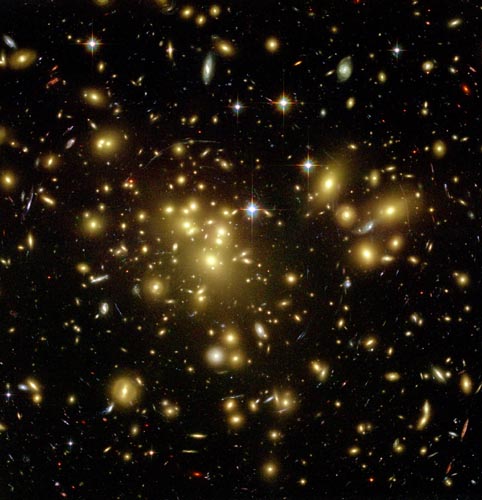
Takes Hubble Deeper into the Universe
Description: Galaxy Cluster, Gravitational Lens
Position (J2000): R.A. 13h 11m 34.20s Dec. -01° 21' 56.0"
Constellation: Virgo
Distance: The distance to the lensing cluster is 2.2 billion light-years (675 megaparsecs).
Dimensions: The ACS image is roughly 3.2 arcminutes (2 million light-years or 630 kiloparsecs) in width.
Exposure Date(s): June, 2002
Exposure Time: 13.2 hours
Image Credit: NASA
Release Date: January 7, 2003
ABOUT THIS IMAGE:
A massive cluster of yellowish galaxies, seemingly caught in a red and blue spider web of eerily distorted background galaxies, makes for a spellbinding picture from the new Advanced Camera for Surveys aboard NASA's Hubble Space Telescope. In the image hundreds of galaxies many billions of light-years away are smeared by the gravitational bending of light into a spider-web tracing of blue and red arcs of light. To make this unprecedented image of the cosmos, Hubble peered straight through the center of one of the most massive galaxy clusters known, called Abell 1689. This required that Hubble gaze at the distant cluster, located 2.2 billion light-years away, for over 13 hours. The gravity of the cluster's trillion stars — plus dark matter — acts as a 2-million-light-year-wide "lens" in space. This "gravitational lens" bends and magnifies the light of the galaxies located far behind it.
The Advanced Camera's IMAX movie-quality sharpness, combined with the behemoth lens, reveals remote galaxies previously beyond even Hubble's reach. A few may be twice as faint as those photographed in the Hubble Deep Field, which previously pushed the telescope to its sensitivity limits. Though much more analysis is needed, Hubble astronomers speculate that some of the faintest objects in the picture are probably over 13 billion light-years away (redshift value 6).
Though gravitational lensing has been studied previously by Hubble and ground-based telescopes, this phenomenon has never been seen before in such detail. The ACS picture reveals 10 times more arcs than would be seen by a ground-based telescope. The ACS is 5 times more sensitive and provides pictures that are twice as sharp as the previous work-horse Hubble cameras. So it can see the very faintest arcs with greater clarity. The picture presents an immense jigsaw puzzle for Hubble astronomers to spend months untangling. Interspersed with the foreground cluster are thousands of galaxies, which are lensed images of the galaxies in the background universe.
Detailed analysis of the images promises to shed light on the mystery of dark matter. Dark matter is an invisible form of matter. It is the source of most of the gravity in the universe because it is much more abundant than the "normal matter" that makes up planets, stars and galaxies. The lensing allows astronomers to map the distribution of dark matter in galaxy clusters. This should offer new clues to the nature of dark matter. By studying the lensed distant galaxies, astronomers expect to better trace the history of star formation in the universe, over the past 13 billion years..
The picture is an exquisite demonstration of Albert Einstein's prediction that gravity warps space and therefore distorts a beam of light, like a rippled shower curtain. Though Einstein realized this effect would happen in space, he thought it could never be observed from Earth. Though individual stars lens background light, the deflection was too small to ever be seen from Earth. When the laws of relativity were formulated in the early 20th century, scientists did not know that stars were organized into galaxies beyond our own Milky Way. Great clusters of galaxies are massive enough to warp space and deflect light in a way that is detectable from Earth. The Abell cluster is the ideal target because it is so massive. The more massive a cluster, the larger the effects of gravitational lensing.
This representative color image is a composite of visible-light and near-infrared exposures taken in June 2002